Your Life is Important
We're care about our Citizens
Motorcycle Rider’s are requested to obtain their driving license must.
Road Safety Rules
Instructions for Car Drivers
Always carry your driving license and important documents such as your vehicle registration certificate with you while driving
Instructions for PSV Drivers
Always carry your driving license and important documents such as your vehicle registration certificate, fitness certificate and route permit with you while driving.
Instructions for Motorcyclists
The motorized two-wheeler rider is the one most likely to sustain serious injuries no matter what he hits- a pedestrian, a cat or another vehicle. Hence, the use of helmet is supposed to save the life.
Instructions for Bus and Truck Drivers
They should be driven on the extreme left, speed governors are mandatory for them and the maximum speed limit for buses and trucks is 40 KMPH in city areas.
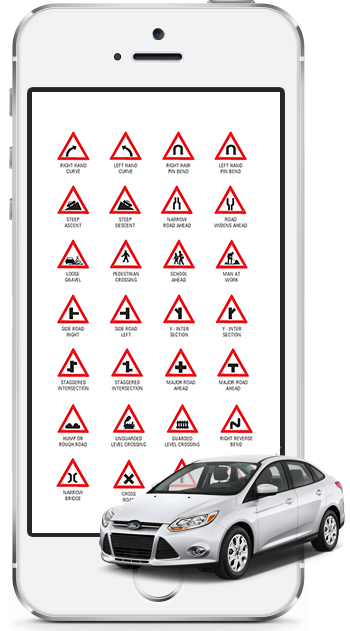
Instructions for Bus Commuters
Bus commuters should never board or dashboard a moving bus. Maintaining a queue while boarding the bus will help avoid unnecessary hustle and bustle and will also save time.
Instructions for Cyclists
Ride in a straight line for 10 meters
Instructions for Pedestrians
The most important safety tip to reduce pedestrian injuries and fatalities is to pay attention.
Instructions for Children
The advice given below on crossing the road is especially for children.
DIVIDING LINES
A dividing line is a road marking formed by a white/yellow line or two parallel white/yellow lines (broken or continuous) designed to separate
 the parts of a road to be used by vehicles travelling in opposite directions.
the parts of a road to be used by vehicles travelling in opposite directions.
Broken Line (or Broken Line to the left of a Continuous Line
You must keep to the left of these lines. You may cross them to overtake or make a turn, but you must only do so if it is safe.
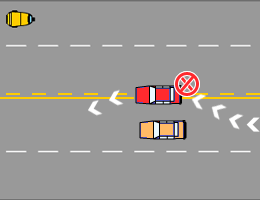
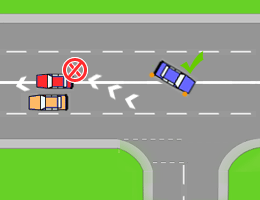 Single Continuous Line (or Single Continous Line to the left of a Broken Line).
Single Continuous Line (or Single Continous Line to the left of a Broken Line).
You must keep to the left of these lines. You must not cross these lines to overtake or make a U-Turn but may cross them to enter or leave the road or
to go past an obstruction..


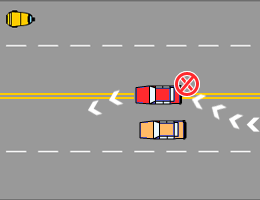 Parallel Lines.
Parallel Lines.
You must keep to the left and must not cross these lines, unless you have to avoid an obstruction.
Avoiding an obstruction
You are permitted to cross single or double continous lines in order to avoid an obstruction – This does not include a slower moving vehicle or a vehicle stopped in a line of traffic, but may include a fallen tree, a crashed vehicle, or a car that has broken down or is illegally parked. Before crossing the line, you must have a clear view of the road ahead and it must be safe. You must also be very sure that you cross safely because the onus is on you to take the risk of danger into account.
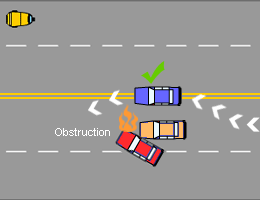
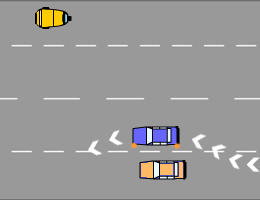 Broken Lane Line.
Broken Lane Line.
When lanes are marked by broken lines the driver may change lanes when it is safe to do so by indicating the intention through proper signal..
Straddling
When driving on a road marked with Lane Lines, you must keep your vehicle entirely within a lane. It is an offence to straddle a line. The red car in the illustration is straddling the lane line.
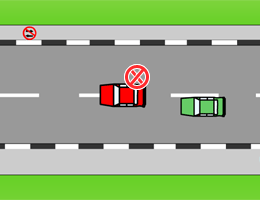
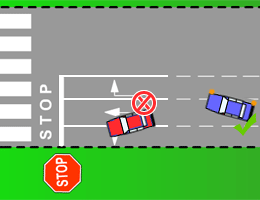 Solid Lane Line.
Solid Lane Line.
The lanes near intersections are often marked by Solid Lane Lines where no lane changing is permissible. The traffic driving along such lanes bound by solid lines has to move along the same direction or the direction indicated by road marking arrows thus a No-Lane changing zone is created near intersection to prevent last minute change of direction by the traffic, that may obstruct the smooth flow of traffic & cause accidents.
Motorists are expected to change lanes while driving in the Lane Change Zone (marked by lanes with broken lines) so that they are in the appropriate line when they enter the No Lane Changing Zone near the intersection. (marked by Solid Lane Lines) . The red car in the illustration iscommitting an offence.
EDGE LINES
These are continous lines at the edge of the carriageway and mark the limits of the main carriageway upto which a driver can safely venture.
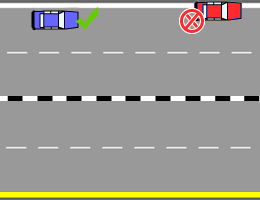
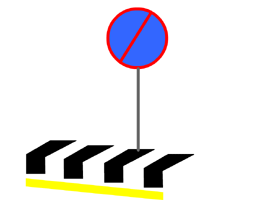 Yellow Edge Lines.
Yellow Edge Lines.
You must not stop or park your vehicle in any area where a continous yellow edge line is applied even to pick up or set down passengers or goods..
